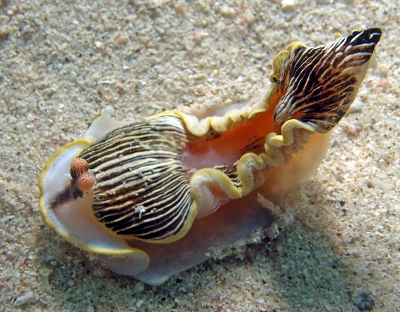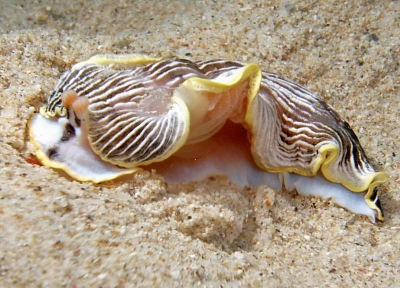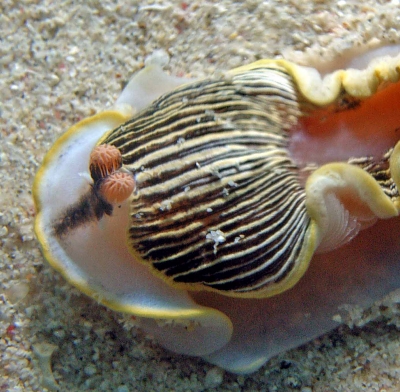Re: Armina wattla (?) from Bonaire
November 20, 2006
From: Marge Lawson


Concerning message #15650:
Hi Bill,
I live on Bonaire part time, and during the past six weeks I've found 3 different Armina nudibranchs in the sandy area just north and just south of the Sand Dollar dock at Bari Reef. All were found during the day, and were mostly or partially buried in the sand. I don't have a photo of the third Armina, but the first 2 are similar in appearance with stripes at the head and the tail, but none in the middle. The dark stripe down the face is slightly different. They both lack the "smile" of the Smiling Armina in the "Reef Creature Identification" book.
Locality: Bari Reef, 10 to 15 foot depth, Bonaire, Netherlands Antilles, Caribbean, October and November 2006, sandy bottom. Length: 1 to 1 1/4 inches. Photographer: Marge Lawson.
Are these the same as Les Wilk's Armina wattla, or are they a different variety?
Marge Lawson
margebonaire@yahoo.com
margebonaire@yahoo.com
Lawson, M. I., 2006 (Nov 20) Re: Armina wattla (?) from Bonaire. [Message in] Sea Slug Forum. Australian Museum, Sydney. Available from http://www.seaslugforum.net/find/18388
Dear Marge,
Yes I think these are the same as the animal in Les Wilk's message. I' afraid identifying Caribbean species of this group is difficult at present because we don't know enough about them - how many species there are? how variable is each species? More importantly a number of species have been described from preserved animals, so we really have no idea what their living colour pattern is. I really don't understand nudibranch specialist naming new species from preserved decolourised animals. Even 18th century ornithologists realised they need to include colour in their descriptions of new species of birds.
Be that as it may, Marcus & Marcus (1967) described A. wattla from preserved material. One distinctive 'colour' feature in the preserved specimen is a median black band on the oral hood as in your animals. For this reason I have identified this species as A. wattla. The animal recently illustrated in Caribbean Sea Slugs [Valdes, Hamann, Behrens & DuPont,. 2006] as A. wattla does not seem to have this black band, or the bright colour border of your animal, so one of us is probably wrong. I think the black band is probably more indicative of the Marcus species, after all the lack of colour in their description is most probably because their specimens were preserved and decolourised.
The other interesting point is why your animals were visible during day light hours. Large arminids are usually hiding in the sand during the day. I think the answer is related to the large bite marks on both specimens. The pink regions without lines, that your mention, are bite marks where something - presumably a fish - has bitten out a large patch of mantle tissue. Perhaps they are sitting exposed on the surface because they were badly injured at night, or perhaps they were bitten because they have come to the surface during daylight hours.
Best wishes,
Bill Rudman
Related messages
-
Smiling Armina from Bonaire
From: Ellen Muller, July 18, 2008 -
Re: Armina wattla (?) from Bonaire
From: Marge Lawson, November 24, 2006 -
Armina wattla (?) from Bonaire
From: Les Wilk, January 26, 2006 -
Armina wattla? from the Caribbean
From: Dave Elliott, September 28, 2002
